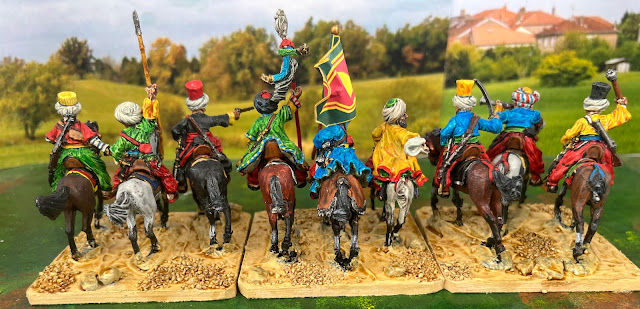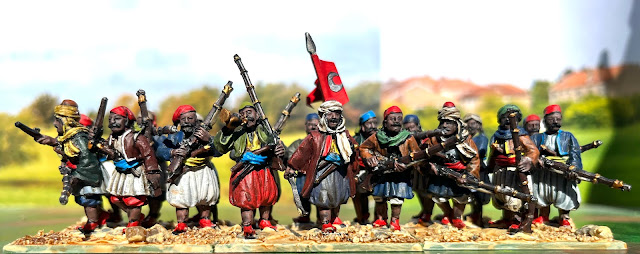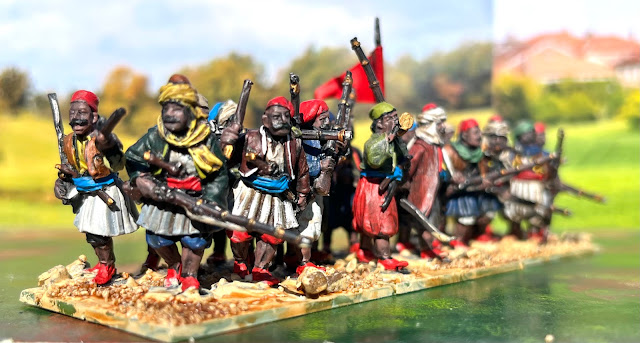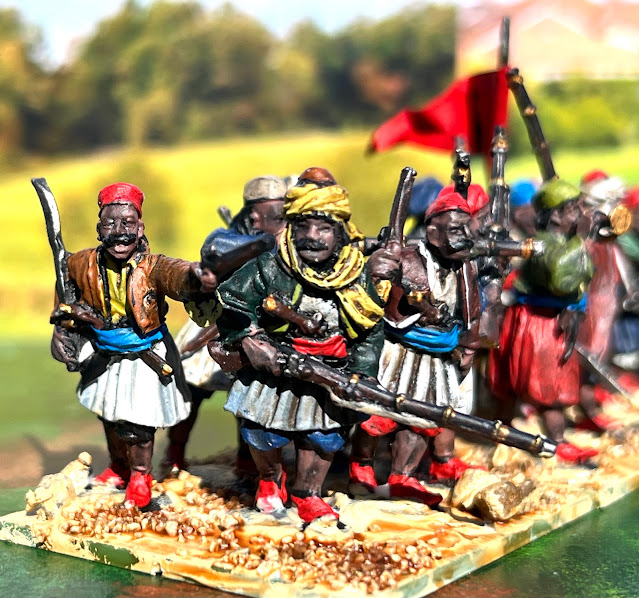Pages
Tuesday, 30 January 2024
Nizam-i-cedid Anatolian nefer infantry
Saturday, 27 January 2024
Making for the Hills...
...or rather, making the hills.
Two more hills have been added to my mix of heights.
The first is a long-ish, low ridge, measuring 600mm long and varying between 200mm and 250mm wide, with a height of around 20mm.
The second is a steeper, more rugged height that is 450mm on the long, around 300mm on the short long axis and about 30mm high. Steep on one face with a rocky outcropping on one end and various areas of erosion across the rest, but with a more gentle approach on the opposite face.
When I started the terrain tile project one of the options was to make tiles with hills built into them, but on analysis it introduced a multitude of problems:
- My tiles are only 300mm x 300mm so the size and shape of heights is restricted, unless I was to make tiles that joined with others, but that would have created a complex number of tiles.
- Then what if I wanted a road or a stream beside the hill, this would increase that complexity and number of tiles again
- Storage becomes more complex because the tiles as as they are can stack on top of one another without damaging them, whereas as a hill tile would have odd shape and would stack awkwardly and would damage easily.
Having hills that sit on top of the tiles seemed to be the simplest way around the problem with no more than a dozen hills in different shapes. It also solved another problem for me. I have always liked that way that terrain tiles give the option to sculpt terrain below the surface: to have rivers and streams with real banks, to have sunken roads and dips in the ground, but what has always ruined the aesthetic for me is the checkerboard effect that tiles can create. Placing items like hills, woods, buildings, fields, etc on top of the tiles helps to cover and disguise the joins, as shown here.
 |
| The checkerboard effect |
 |
| The checkerboard effect minimised with a wood, a field and two hills |
That checkerboard effect is made worse in my case because I have made them super light - a standard tile weighs less than 200 grams (7 oz) - so in play they are going to get knocked and will move around easily and create the gaps that will offend my eye. My initial solution was to use rare earth magnets to hold the tiles together, but it meant buying some 300 magnets and initial tests did not go all that well. The answer for me was to build an adjustable edge that could be attached to my table that would lock them in place.
So I made plans to build this edge, an edge that would not only lock the tiles in place but would also extend my table on both axies to turn my 1525mm x 2740mm table tennis table into a 1800mm x 3000mm table. I bought all the MDF sheeting I need prior to Christmas and the plan was to complete the work before my return to work on 3 January. This was to be my main summer project. But alas my plans were thwarted by my medical problem earlier this month which prevents me from anything too strenuous for the next couple of months. The MDF sheeting itself is not all that heavy, but it is awkward to handle and since I lack a workshop the cutting of the MDF has to be done outdoors (otherwise there is likely to be a severe amount bleating about MDF sawdust in the garage from Domestic Control) which would mean carrying the MDF out the side door of the garage, down a narrow path, past the washing line to an area where the saw horses can be set up. Frustratingly this awkward manoeuvring makes the task impossible in my current condition.
And this, dear reader, is why hills, and a few other items, will feature heavily on these pages over the next month.
Thursday, 25 January 2024
Mamelukes, Unit Number Seven
Monday, 22 January 2024
I Must go Down to the Sea Again...
...and I have been in a way, completing the last three shoreline terrain boards and four all sea boards.
But first, the hill that I worked on earlier has been drybrushed with bright green and yellow to give the dark green felt some tone and is now completely finished. Other heights are in progress.
Of the terrain boards two are just straight beach sections.
Saturday, 20 January 2024
More Albanian Infantry
Wednesday, 17 January 2024
Monday, 15 January 2024
Over the Hills and Down to the Sea
I am getting back into my summer terrain projects: the hills and the shoreline terrain tiles.
The hills are going to be worked over a period of time, probably one or two at a time. The first thing to do was to finish off the one that I started before Christmas and I set to fixing the felt to the surface. This was done by brushing PVA across the entire surface, ensuring that the PVA is thin enough to slightly permeate the felt, but still thick enough to bond to the polystyrene. The felt has to be stretched a bit to take the shape. This is then left to set hard.
When fully set more glue is applied to the edge - the value of the rough edge to the MDF now comes into play with the glue having something to soak into - and the felt pulled tight over the edge, pinned or taped to the undersides of the MDF base and left to set.
Then with a sharp blade the excess felt is trimmed flush to the underside of the base. Any loose edges were then re-glued. The hill is now ready for dry brushing in lighter tones, a task that will be left until I have a number of pieces ready to go.
During the times when glue was setting on hill piece, I continued work on the two shoreline terrain tiles. The first step was to fill all the gaps with some wood filler. On the estuary tile I wanted an area of rocks extending out from the shore which I made using some pieces of bark from the garden. Once fixed in place the bark was liberally coated with PVA to seal it and prevent it breaking apart later. Also since these did come from the garden the PVA coat ensures that any nasty little microbes are contained within.
Then I sketched out the shoreline and applied sand to the 'beach' areas with the waterline sitting at 150mm (dead centre) of the tile sides. There is a story behind this sand. On one of our trips around the country before our borders reopened we made a visit to Golden Bay, a beautiful spot at the top of the South Island. As we sat there with our picnic lunch, I commented "this is really nice sand". "Really!?", was the response. So under rolled eyes I 'foraged' some 2kgs of the stuff in a plastic bag and we went on our way. A few days later we were ready to fly home and the Domestic Controller decided to put the sand in her carry-on bag and that was fine and dandy until the aviation security people x-rayed the bag and took an interest. They dragged her bag off to one side and quizzed her. To save the situation (and not to be made to look like a total weirdo) I said it was sand for the aquarium (that I have never owned or intend to own) and they were gave a sort of knowing nod and let us go on our way, but I could see from the daggers pointed at me that I was going to have to claw back from this, and I was right...But back to the beaches. I wanted to use the upward slope as dunes so I put a couple of tracks leading up through the dunes.
Once the glue was dry I painted the whole area a light yellow sand colour that I have used on some of my desert bases and washed it with a thinned down sepia. Then it was lightly drybrushed with some Wraithbone white to make it more beach than desert like. I then applied a slightly darker wash to give the appearance of wet sand where the tide has receded a little. The sea areas were given a couple of coats of acrylic paint to prevent any possibility of warping when the water texture is applied. The rocks were also painted black.
I added a few pieces of driftwood, above the high tide mark where storms would have driven them, made by painting some twigs from the garden with Wraithbone white.
Felt was glued on the edges of the tiles that conjoin with other standard tiles. This is a good way to use up the off cuts of felt from the hills. This felt will get drybrushed when I do the hills. Then various pieces of ground cover were added to merge between the sand and the felt.
Before the water texture was applied the rocks were toned up by dry-brushing them with grey and then very lightly with Wraithbone white.
The water was made using a technique I learned from a YouTube video for model railways using toilet paper and PVA glue. I won't go into detail about how to apply the technique, but interested readers can find a tutorial here. Once the paint had dried I applied several coats of acrylic gloss varnish. As much as I was tempted to make this a stretch of rough water, I also realised that at some point I will want to put boats on top of this, so I made it a gentle sea.
Two tiles down, three to go.
Saturday, 13 January 2024
Albanian Infantry
Made up of predominantly Albanians and Circassians the Bashi-Bazouks were a volunteer force in the Ottoman army. Known for their brutality they lived largely off the land. Unpaid they lived off loot.
I'm not certain that the Bashi-Bazouks served in the Egyptian Campsign, but they are a hard unit to resist.



















































